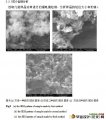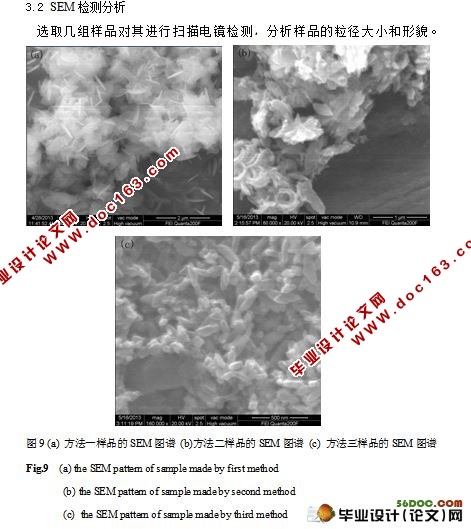纳米钛酸锂锂离子电极材料的制备及性能研究

纳米钛酸锂锂离子电极材料的制备及性能研究(含任务书,开题报告,外文翻译,毕业论文8700字,答辩PPT)
摘 要
近年来,人们一直在努力寻找能符合更高要求的的新型锂离子电池的电极材料。其中,具有尖晶石结构的Li4Ti5O12材料是一种“零应变”电极材料,Li+插入和脱出对材料结构几乎没有影响,具有循环性能优良、放电电压平稳、1.55V 相对较高的电极电位,能够在大多数液体电解质的稳定电压区间使用、材料来源广、清洁环保等优点而日益受到重视。本文所讨论的尖晶石结构的Li4Ti5O12,采用直接水热法合成的纳米材料,通过不同的合成原料,n(Li)/n(Ti),反应条件制得五组不同的样品,然后通过X射线衍射仪(XRD),扫描电镜(SEM)以及差热分析仪等检测手段对样品进行检测分析。
结果表明,本课题采用的五种方法均没有制得目标样品Li4Ti5O12,都是TiO2。分析原因可能有以下几种:水热合成时,水热环境呈酸性,NH4+离子配位性强的影响等原因导致Li+不能与TiO2反应,使得不能合成出目标产物。此外,还有些尚不明确的原因同样导致本课题没有合成出Li4Ti5O12。上述遗憾将会在以后的学习过程中逐渐弥补。
关键词:钛酸锂;锂离子电池;水热法;纳米材料 [资料来源:Doc163.com]
Preparation and performance of nano
Lithium Titanate Lithium ion electrode materials
Abstract
In recent years, people have been trying to find higher demands of a new type electrode material of lithium ion battery. In these materials, spinel-type structure Li4Ti5O12 is a “zero strain” electrode material. Lithium ion’s inserting and out have no influence to the structure of material. There are so many advantages of Li4Ti5O12 leading to it taken more attention by people. The spinel-type structure Li4Ti5O12 in this thesis is prepared by hydro-thermal method, and it is a kind of nanometer sheet material. It is prepared through five method: different crude material, different n(Li)/n(Ti), and get five group different samples. Those samples are checked by XRD, SEM and DTA.
The results indicate that the five group samples are TiO2,not Li4Ti5O12。There are some possible reasons. While the hydro-thermal is happening, the surroundings of the solution is acidity. NH4+ ion exists in the solution. These reasons lead to Li+ and TiO2 having no action. And there are some unknown reasons leading to the same results. It would be selected in future study. [资料来源:www.doc163.com]
Key words: Lithium Titanate; Lithium ion electrode; hydro-thermal method; nano material

目 录
摘 要 I
Abstract II
1 引言 1
1.1 锂离子电池的发展背景 1
1.2 锂离子电池负极材料的特性及研究进展 2
1.2.1 锂离子电池负极材料的特性 2
1.2.2 锂离子电池负极材料的研究进展 2
1.3 Li4Ti5O12材料概述 3
1.3.1 Li4Ti5O12的结构与性能 3
1.3.2 尖晶石型钛酸锂的制备方法 4
1.4 本课题的研究内容 6
2 实验材料及实验方法 7
2.1 实验原料及仪器设备 7
2.2 实验方法 8
2.3 样品检测 9
2.3.1 XRD检测 9
2.3.2 差热分析检测 9
2.3.3 SEM检测 9
3 实验结果和讨论 10
3.1 物相检测分析 10
3.2 SEM检测分析 15
4 总结 16
参考文献 17
致谢 19
[版权所有:http://DOC163.com]
